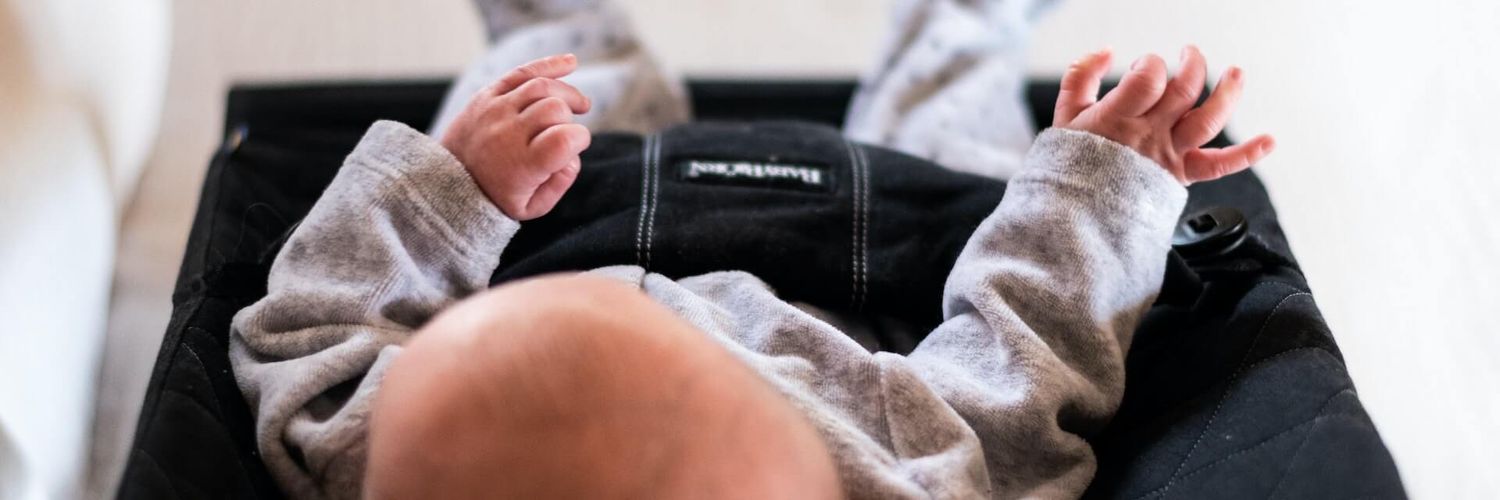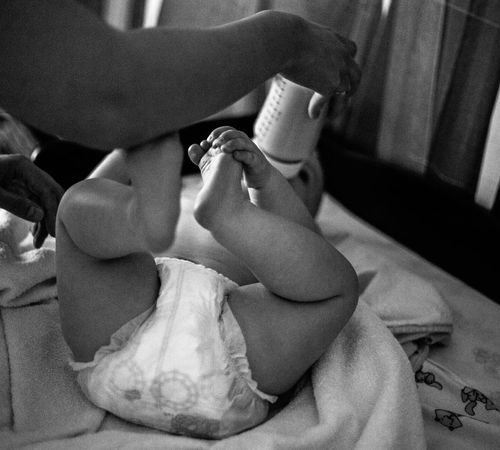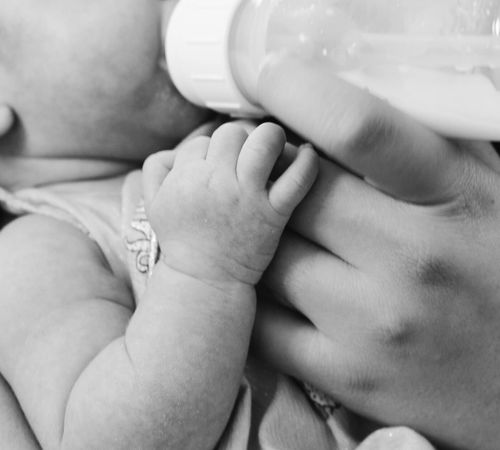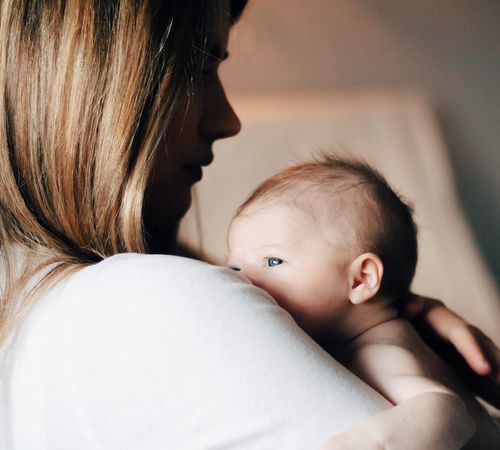Many babies will wake after one sleep cycle and have trouble falling back to sleep without their parent's help. Here are 6 solutions to try that will help your baby connect sleep cycles and sleep for longer stretches during naps and at night.
If you landed on this page, then you have my sympathies. Because either you have a cat napping baby that will never sleep longer than one sleep cycle. Or you have a baby that wakes up at night A.LOT.
Whatever it is from the two, I feel you, and I am here to tell you that you have come to the right place.
I guess you also have researched why your baby wakes or only naps for 30 minutes every single damn time. You know it, I know it, and every sleep consultant on this earth knows it:
Your baby cannot link sleep cycles on their own.
They wake up from a nap or at night and need your help to fall back asleep, leaving you completely restless and sleep-deprived.
Well, in this article, we will talk about sleep cycles, why your baby cannot connect sleep cycles, and if this is really the only reason why your baby wakes so often.
This article covers:
What Is A Sleep Cycle?
A sleep cycle is a recurring pattern of brain waves while sleeping. It consists of different sleep stages, either light sleep or deep sleep.
When going through a sleep cycle, we traverse through those different sleep stages. Once we have gone through a complete sleep cycle, the next sleep cycle starts.
What Does A Baby Sleep Cycle Look Like?
The sleep cycle of a baby and an adult differ in several ways.
An adult's sleep cycle is 60-90 minutes long, while a baby's sleep cycle is 40-60 minutes long. Adults go through 3-5 sleep cycles at night, while babies go through 12-14 sleep cycles!
Before 4 months, babies only have two sleep stages, a light sleep stage, also called REM sleep, and a deep sleep stage also called non REM sleep. The time spent in both those sleep cycles is evenly divided. The sleep cycle of an adult, however, consists of 4 sleep stages.
Then at 4 months, many babies experience the 4 month sleep regression. This is a phase where your baby's sleep cycle changes and becomes more similar to an adult sleep cycle. They will now gain two additional sleep stages, both, sorry to say it, are also light sleep stages. So now your baby spends even more time in light sleep than before. That is why so many babies sleep worse once they hit their first sleep regression.
Daytime Sleep Cycles Vs. Nighttime Sleep Cycles
You may have noticed that your baby always has short naps during the day but sleeps two hour stretches at night. But how come so?
Daytime sleep and nighttime sleep differ. Melatonin production is at its peak at night, and sleep pressure is much higher. All these things work in your and your baby's favor making them capable of connecting at least two or even more sleep cycles, even if they cannot do this during the day.
Why Do Baby Sleep Cycles Lead To Wakings?
Now, the thing is that no one completely sleeps through the night without waking. You don't, I don't, and for sure, that freakin cute baby of yours doesn't. Even adults wake when their sleep cycles end. We usually go back to sleep without noticing or remembering it because our brain is developed enough to do so.
But that doesn't go for babies. They are developmentally not there yet, so they will often wake fully after a sleep cycle and need your help to get back to sleep.
Also, a baby's sleep cycle is shorter, which means they spend more time in light sleep hence they wake up more often. Babies, especially young babies, are also more prone to sleep disruptions such as temperature changes, light, or noise.
How To Help Your Baby Connect Sleep Cycles
Even though a big part of being able to connect sleep cycles depends on development, there are still things to try that can help your baby resettle to sleep or achieve a longer nap without your active or less help.
1. The Wake-To-Sleep Method
The Wake-To-Sleep method is a popular method to help baby nap longer or sleep for longer stretches at night. It is used for habitual wakings and when baby always wakes at the same time.
Thereby, you slightly wake your baby before they would wake on their own and then settle them back to sleep with minimal help. The idea is that you "program" your baby's body to sleep for a longer stretch and help them to connect the sleep cycles.
You can read in the article below a very detailed description of how this method works.
2. Introduce New Sleep Associations To Wean From Old Ones
If you have to help your baby fall asleep with strong, active sleep associations like feeding or rocking to sleep every time they wake, then it can be very helpful to slowly wean from these strong sleep props so they can go back to sleep by themselves.
Thereby, you should first introduce new sleep associations that are easy to wean and that you can easily use with your baby lying in the crib. For example, patting your baby's bum or shushing are very effective sleep associations.
When you get your baby to sleep, you will add these new sleep associations while also using your old way of getting them to sleep. Then you will slowly decrease your rocking or feeding and only use patting or shushing. The goal is to wean from those strong associations completely and only help them back with your new sleep associations. And once you have achieved this, babies usually do not rely on those weak associations to go back to sleep but often do it on their own.
3. Introduce Regular Nap Time
A regular and repetitive pattern during the day will help set your baby's circadian rhythm to specific nap and bedtimes. You don't necessarily need to have a strict nap schedule, but having the same nap times +/-30 minutes can help set that internal clock of your baby.
If, for example, you want to stretch the length of your baby's naps, you should try to get them to nap at more or less the same time every day for the same amount. If you can keep up this pattern for about two weeks, your baby's body should get used to sleeping at the same time for the same length, and you will have successfully lengthened their nap.
In this article, you can find a detailed description of how to lengthen your baby's nap.
4. Stretch The Time Between Night Feedings
This method is often used to wean babies from night feedings or to eliminate specific feedings. It works very well if your baby has a fixed pattern of waking, for example, wakes every two hours, or always wakes at the same times throughout the night.
The idea is to delay the feedings slowly every couple of days for about 5-10 minutes and settle them back to sleep without a feed so that eventually, in the end, it will overlap with the next feed, and you have eliminated this specific feed.
To do this, you will pick a feed of the night. It is best to choose one in the first half of the night because sleep pressure and melatonin production are the highest, and you will have an easier time settling your baby back to sleep. Also, it's better to pick the second or third feed of the night since the first feed will give them some extra calories and fill their emotional cup.
Once you have picked out a feed or a specific time, you will not offer the feed as usual but hold it off for 5-10 minutes and try to settle any other way. You will keep this time for the next couple of days and delay it then by another 5-10 minutes, and so on.
In this article about night weaning, you can read more about this method.
5. Put Them To Bed Really Sleepy
This method works similarly to drowsy but awake. I know, I know. I have previously written about how it's practically impossible to find the drowsy but awake moment, and I still believe it is.
This method works more by aiming at a really, really sleepy state. The idea is that if your baby falls asleep in the crib, they will continue to sleep even if they wake after one sleep cycle. However, this method works best for very young babies up to 4 months. After that, babies become very aware of their surroundings, and this method can be tricky.
With this method, you will help your baby fall almost asleep the usual way (e.g., by feeding or rocking). Once you notice that your baby's eyes are getting really heavy and start to close and open very slowly, it's time to put them down into the crib. They might wake slightly when you put them down. Then help them fall asleep by stroking, patting, or shushing. The idea is that your baby will do the last little step of falling asleep on their own.
You will probably fail the first few attempts. But don't give up. Continue trying this method every day for one nap, and your baby will get used to falling asleep in the crib and hopefully staying asleep.
6. Use Patience Stretching
The method of patience stretching is very similar to the method explained before, but it is mainly used for older babies and toddlers (18+ months). Sometimes staying with a toddler until they fall asleep can be exhausting. It takes more time, they constantly talk or stand up, and you are simply over it.
The idea is to teach your toddler that it is ok for you to leave the room, so they fall asleep on their own.
For this method, you will leave for a certain amount of time during the day and get your child used to practically being alone for a little while. For example, while they are playing, you will say that you will leave very shortly to go to the bathroom. After a couple of minutes, you will return. This will signal to your child that you will always return to them and are always there for them.
Then you will say something similar while you get them to sleep but also return after a few minutes. Your child will then learn that when you announce that you will be back, you will indeed be back, and they will learn to wait.
Every couple of days, you will increase the time you are away. First 10 minutes, then 20 minutes, then maybe even 30 minutes which we have to make clear is a long time in little child dimensions. But you always have to return. And you will do the same during bedtime. Hopefully, your little one will then fall asleep while you are out. They will learn that it's ok to fall asleep on their own.
But make sure to go back and check on your baby just as you promised!
Connecting Sleep Cycles - The Ultimate Solution?
Whether your baby is going through the 4 month sleep regression or wakes at night, the ultimate solution to end those sleep struggles seems to be self-soothing. On the majority of web pages, you will read about sleep consultants advising you to teach your baby to self-soothe.
But why?
Because according to them, if a baby can settle entirely by themselves, then they can connect sleep cycles and resettle themselves to sleep without calling for you.
But is that really true?
Well, I am here to tell you that it may only be partially true. While the ability to self-soothe can help some babies sleep better, it sounds like quite a simple solution to such a big sleep problem that so many parents around the world are dealing with, don't you think?
Self-settling or self-soothing may play a certain part for some babies, but there are still other valid reasons why your baby only has cat naps or frequently wakes at night. That is why conventional sleep training doesn't work for so many babies. They only aim at self-soothing.
So let's explore all the other possible reasons why babies wake:
Hunger: The most common reason in newborns and babies up to one year. Especially after 4 months, many babies need more calories because they are now growing big time. Also, the assumption that after introducing solids, babies are not hungry anymore at night is not true. They are primarily getting vegetables or fruits, both lower in calories than calorie-rich milk.
Protective Wakings: As annoying as wakings can be, they also serve a very important role: they protect your baby! Night wakings protect your baby from possible low heart rate or a breathing problem. Babies are designed by nature to wake easily as a protective measure.
Emotional Reassurance: Sleeping through the night is a developmental milestone that each and every baby hits at a different age. We need to accept that the emotional need of a baby to be close to a parent and be reassured by their attendance is a valid need.
Undertiredness/Overtiredness: A baby that is under- or overtired will often have trouble sleeping well. Both can lead to cat napping or struggles when falling asleep. That's why finding the right time to put your baby to sleep is so important. You can do this by following your baby's tired signs and an age-appropriate awake time.
Discomfort: A sick baby or a baby dealing with any illness or discomfort will wake up more often at night. While sleep is what you need to get better, it is very difficult to sleep when you feel unwell or are too hot or cold.
So if there are so many other reasons why babies wake, then why should you even attempt to teach your baby to connect sleep cycles?
Well, there is also the possibility of habitual waking, especially in older babies and toddlers. So if you are positive that your baby is only waking out of habit and constantly wants to be fed or rocked to sleep, then working on setting boundaries and teaching them other ways to get back to sleep (aka connect sleep cycles on their own) can help them improve their sleep.
I personally don't believe that CIO is necessary to do so. If you try out the methods above, you will see success even if it takes more time than sleep training methods which include crying. But your baby is heading in the right direction, and you are setting the stage for better sleep in the future.
Summary
Remember that not every solution works for every baby. Your baby's ability to connect sleep cycles and sleep for longer stretches depends on so much more than on the ability of self-soothing. Temperament also plays a big part and will decide how fast and if a method works for your baby. But I also want you to know that eventually, your baby will learn to connect sleep cycles entirely on their own. Yes, it will take more time, but it will happen.
However, there is nothing wrong with practicing independent sleep and setting boundaries as a parent that help you stay sane when it comes to baby sleep. But consistency is key if you want to establish regular patterns of sleeping. So be patient and keep on trying.








